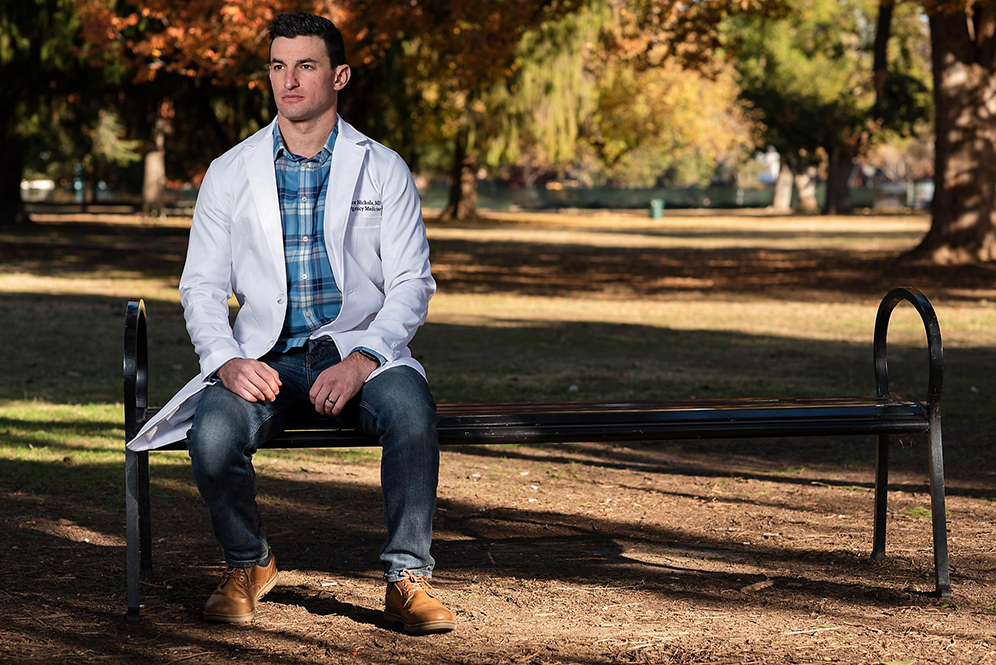

For many, the U.S. has never felt more divisive than it does today. Misinformation, hate speech, and conspiracy theories run rampant online, pitting different groups of people against each other. As a provider, you may have to take care of someone who goes against your personal beliefs. They may even appear to dislike you as a person and everything you stand for.
That was certainly true for Dr. Taylor Nichols, who works as a doctor at University of California San Francisco and an emergency room physician at Mercy San Juan Hospital just outside Sacramento. He specializes in caring for Medicaid patients, including low-income and homeless individuals, as well as those struggling with addiction.
One particular day began like any other, until a man came into the emergency room struggling to breathe. Dr. Nichols and his team began administering treatment to the patient and discovered a slew of swastika tattoos all over his body. For the young doctor, who is Jewish, it could have been a crisis of faith.
Pushed to the Breaking Point by COVID-19
Like many of his colleagues, Dr. Nichols has seen his fair share of death over the last ten months. He’s been treating coronavirus patients daily, watching countless people die from the disease. With few breaks and constant risk of exposure to the virus, he’s reaching his breaking point.
“I see no matter how much we scream from the mountaintops, we’re getting overwhelmed,” Nichols said. “I see COVID patients every day. It’s endless.”
But that’s exactly what he signed up for when he became a doctor.
Dr. Nichols chose to go into medicine after going to the hospital as a child to have a tumor removed. “I decided while I was in the hospital that I thought there was nothing greater in the world you could do for another human being than to dedicate your life to have the skills to save them,” he said.
He started working at a Medicaid clinic to take care of people that often slip through the cracks in society. In the age of the coronavirus, his work also involves caring for people that don’t believe the threat is real or that COVID-19 is just a hoax.
“It’s hard to go from one room where somebody dies on you and go into the next room of the one who killed them,” he said. “I’ve always been able to keep going, close my eyes for a second and say to myself, ‘If you’re not going to do it, who will?’”
A Question of Compassion
Dr. Nichols was ready to roll up his sleeves and go to work when the man with the tattoos showed up in the ER. He remembers looking down at the man’s body, the ink-printed swastika moving up and down with each breath, with a team that includes a black nurse and Asian American respiratory therapist. At the time he thought, “I don’t know if I care,” saying he didn’t feel compassion for the man in that moment, even as he shouted, “Don’t let me die, doc.”
He later recounted the entire experience on 17 posts on Twitter.
Dr. Nichols wrote that the man looked scared and sick, which meant he likely had the virus. The patient was “solidly built, his methamphetamine use over the years had taken its usual toll and his teeth were all but gone,” he wrote online.
As he struggled to care for the patient, he wondered whether the man would do the same thing for him if their positions were reversed. He couldn’t help but think about the doctors who sent Jewish prisoners to concentration camps during the Holocaust.
The man’s condition soon worsened, and it became clear that they would have to intubate him if they were going to keep him alive. This is considered one of the most dangerous and risky procedures to perform during the pandemic. Providers must get close to the patient, increasing the risk of viral transmission.
For Dr. Nichols, he wasn’t sure if it was worth the risk. He remembers standing outside in the hallway checking his protective gear, whispering the healthcare mantra, “Anyone, anytime, anything,” under his breath.
However, he soon rose to the occasion to save the dying patient. Whenever the job gets hard, he tells himself, “They came here needing a doctor, and dammit, Taylor, you’re a doctor.”
He quickly intubated the patient and moved onto the next one, but the situation still haunts him. He admits he doesn’t even remember the man’s name. He also doesn’t know whether he ultimately survived or if he tested positive for COVID-19.
For Dr. Nichols and his colleagues, it was just one memorable experience in a long slew of shocking moments as the pandemic rages on. Looking back, he didn’t want to turn into someone he doesn’t recognize just because the job got to be too much.
“You have the realization that maybe you’re not the same person that you started out as and that’s hard to swallow,” he said. “None of us wanted to be changed for the worse because of this.”
When we discuss students, we always mention their qualities. Those qualities show what they are…
If you or someone you know is juggling mental health issues alongside substance abuse, understanding…
For the last couple of weeks, the Israel-Hamas conflict has taken over the news cycle.…
Our eyes are invaluable, serving as our windows to the world. The ability to see…
Undoubtedly, one of the most demanding and challenging professions is nursing. Nurses work long hours in…
Echocardiography, or echo for short, is a key diagnostic test used by cardiologists to assess…